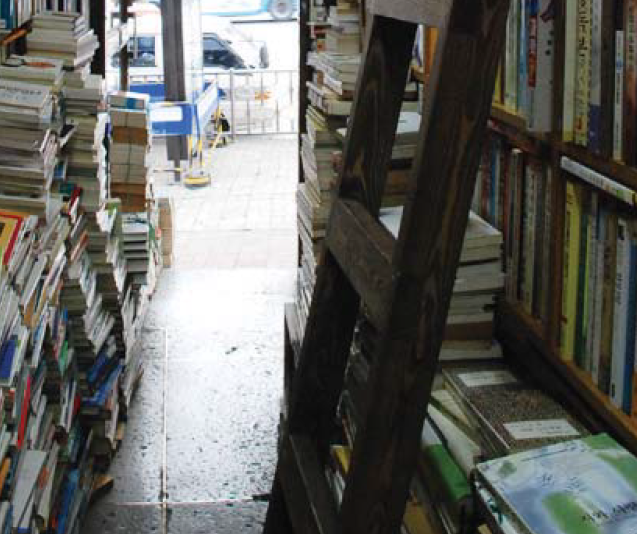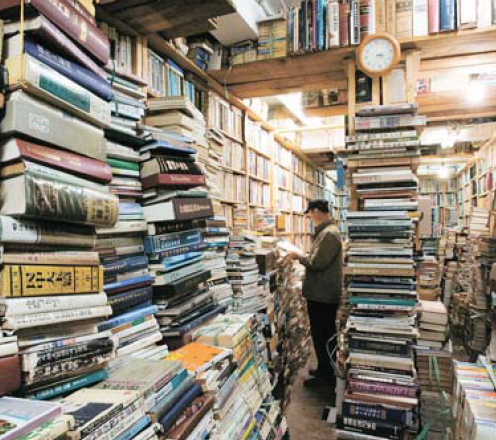
What can you imagine about a secondhand bookstore? Does your image include an old owner, a stack of books, a bookshelf covered with dust, a faded bookmark with yellow color, and the smell of musty mold? Then you may be an unhappy person who doesn’t know about evolving secondhand bookstores. Now the secondhand bookstore is not only for the space to sell the books. It is changing as the space where you can read books, watch a movie, discuss, or study.

Tresure Hunt Game in Old Books
Problem of Koreans who don’t read books is not something that started just yesterday. Last year 3.2 out of ten Korean adults didn’t read even one book for a year, and it moved continuously downward since 2007.1 Presently, the recession of the publishing market has become the topic of frequent articles in the newspaper every year. Adding insult in injury, as tablet PCs are released, even the remaining publishing markets are giving their seats to e-books. In this situation, the extinction of bookstores seems like a matter of time. Under this circumstance, in which even the grand bookstores are having a crisis, it sounds like almost an impossible story that the secondhand bookstore, existing dimly in the memories of a few people, can survive. Except for several grand secondhand bookstores which have a big fan base with long tradition, the ordinary secondhand bookstores are doomed to disappear just like a video rental store or cassette tape store. However, strangely, the interest in secondhand bookstores is recently increasing in Korea. Is it because of the retro culture which was popular for a while in our society? But it’s too deficient and simple to explain secondhand bookstores’ popularity. Then why is the secondhand bookstore resurfacing? What is the image that people generally have about secondhand bookstores? Lee Yoonji who is the student of Hankuk University of Foreign Studies answered this question, “The secondhand bookstore is something old with books covered with dust and piled up in disarray.” About the same question, Kim Jisoo, student of Sogang University said, “In a television drama, I watched the scene that the main character got to find the book which he had searched for a very long time in the secondhand bookstore accidentally. Because of it, I think I can find very historied and valuable books or the books which are not in a general bookstore. It is a similar feeling to playing a treasure-hunt game in the middle of piled books in a mess.”
Transformation of Secondhand Bookstore
The secondhand bookstore has developed passing through three steps in Korea. It is the first form of the secondhand bookstore that bookstores around Cheonggyecheon bought the books which got to be disposed of to waste paper in junk shops and distributed them.2 It is the image that many people have about the secondhand bookstore as it is - the form that dirt builds up and books are piled up here and there. However, before long, the second generation of secondhand bookstore appeared around Sinchon. At the moment, trading of second hand books started actively and the idea of ‘book master’ emerged. As experts like book master’s appeared, secondhand bookstores began to show an aspect of ‘collection.’3 Unlike the first generation which was the form of gathering abandoned books and selling them, in the second generation, books are sold under the regulated form according to a book master’s taste. Therefore, the secondhand bookstore on this step developed with clubs and showed differentiated positioning, bringing out their strengths. For example, the case of Hidden Book in Sinchon is mainly composed of the publications about art and culture due to the owner who worked as a publisher related to art. Also, starting on-line bookstores with running the secondhand bookstore is the second generation secondhand bookstore as the Internet was becoming generalized in the late 1990’s. Later, what appeared in the 21st century is the third generation of secondhand bookstore. It developed with different features such as showing off size or quality. Unlike the established secondhand bookstores which were run toward the personal taste with small size, making bigger or franchising became important. Secondhand bookstores with this form have the strength that they keep the books clean just like new ones compared to other secondhand bookstores. However, they often receive the criticism such as disappearance of the characteristic analog sensibility secondhand a bookstore usually had. On the contrary, there are the secondhand bookstores which have developed as the space of exchanging various cultural activities with the book as a vehicle. They are village-formed secondhand bookstores smaller than the first and second generation. There are as few as 2000~3000 books and they don’t exceed 30,000 books at most.4 What can we do with these books?

Wonderland giving the Present, Culture
Village secondhand bookstores make local culture with them. Village secondhand bookstores started from the alternative space of the grand bookstore. Instead of a “Wal-mart bookstore” where the same book is displayed in same position after the book was sold, secondhand bookstores as the ‘space’ are getting interest again where people read books, talk about them, and communicate the emotion. Sinchon Bookstore working with the local cultural movement organization is a good example. Fan of secondhand bookstores Lee Junghee (25) said, “I go there because I can get recommended proven books from the owner and the space comes to me as my own room.” In this way, secondhand bookstores are becoming cultural spaces and develop as expanded communities. Visitors including local residents visit there without burden, sell and buy books by themselves. However the most spotlighted form between the third generation of secondhand bookstores is book café-formed secondhand bookstores. People can enjoy the space itself without playing a treasure-hunt game. This idea started from the effort to increase interest in disappearing secondhand bookstores by applying to the book café becoming popular among the youth, including the university students.5 The biggest difference between secondhand bookstores formed like book cafés and book cafés is the book. Despite the name of it, books are still supporting roles in a book café. Most of them are used for a characteristic interior more than used practically. However, books become main characters in the book café-formed secondhand bookstore. Books are practical selling products and every activity is done around them. Differently from the past figure of reading in stacks of books, now people of course read books, drink coffee, give a seminar, and appreciate the paintings. Recently, secondhand bookstores appear that shows plays or films all day once a month. There is a secondhand bookstore around SMU. The name of it is Tori and it opened in 2010 under the purpose of gathering the books changed to ornaments in the home and making the space to study together. Tori holds a book meeting once a week and most visitors are Sookmyungians.6 Baek, Department of English ’11, who often goes there said, “I went there after the exam at first. I think that the strength of secondhand bookstores is talking about the books comfortably with new people or owners.” Regardless of the size or quality, third generation secondhand bookstores have something in common. This is that they break away from the image of a stock warehouse. Previous generations stuck to the unwritten rule, ‘a book is prior to person’ but now it is changed into the opposite. Yoon Sanggeun, owner of Secondhand Bookstore in Wonderland, defined the present secondhand bookstore in his book by the same name. “The space where a person and a book coexist, the space where the culture was made with books, this is the of the 21st Century secondhand bookstore.”7

Crying Out the Secondhand Bookstore in the Center of the World
However, you may still have a strong doubt about the reason why you should go to the secondhand bookstore. The greatest advantage of it is that you can buy books even cheaper than in general bookstores. But the price is not the only reason for your visit to the secondhand bookstore. The past secondhand bookstore was a place to sell used books, but now it is becoming a place of selling and sharing culture. Secondhand bookstores with a stuffy and dusty image are no longer accurate. This place is now being subdivided into a franchise form, an alternative space form and is developing continuously. However most of all, the reason you should have an interest in the secondhand bookstore is this : Books are so short-lived in a general bookstore. As the information age continues, books are published constantly and account for a section in a bookstore. However, slow-selling books can’t stand less than a month and are kicked out to a warehouse or a junk shop. With this present situation of the publishing world, the life force of the books in secondhand bookstores seems surprising. As fumbling around books which are piled up layer upon layer, you can meet the fantastic events which have been passed down over generations. It’s not too much to say that it contains all of our generations. Books in secondhand bookstores are both a time machine and time capsule. We can contemplate and reflect on the age in front of the time found in secondhand bookstores. Jang Wooseok, who is the owner of the secondhand bookstore Mulle Chaekjang and director of independent films, answers about the strength of secondhand bookstores. “Nowadays the young are so tied down to an entrance examination or study for employment that they have a poor opportunity to read the books on humanities and discuss about them. However, this period really needs the humanities more than ever. In that sense, secondhand bookstores can be a great space where the young can perform the various cultural experiment with each other.”8 Are you tired of expensive textbooks? Are you afraid of paying the money in Starbucks or Coffee Bean? Suddenly, do you want to fill your intelligence? How about running to the secondhand bookstore? You can find the wonderland just like Alice and then cry out the secondhand bookstore in the center of SMU.
1 Lee Yoonmi, “Adult’s Rate of Reading Decreased Again,” Herald Media, May 2, 2012.
2 Jo Hyuksin, Kim Youngkeong, “Crisis of the Secondhand Bookstore’s Alley,” Platform, 110-115p, 2010.
3 Same as footnote 2
4 Suh Gwangho, “The Third Secondhand Bookstore Landed Finally in Dalgubul,” Ohmynews, May 4, 2010.
5 Han Sangkook, “Reasonable Transformation of Secondhand Bookstore in Wonderland,” Moneytoday, May 11, 2011.
6 Lee Yoonjoo, “The Reason of Popularity of 2000’s Secondhand Bookstore,” Internet Hankook Ilbo, January 15, 2010.
7 Yoon Sanggeon, “Secondhand Bookstore’s in Wonderland,” Imagine, 2009.
8 Koo Hyunjung, “Disappearing Secondhand Bookstore’s Subtle Charms,” Dajungdagam, May 25, 2011.


